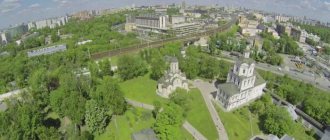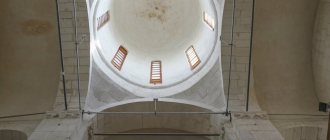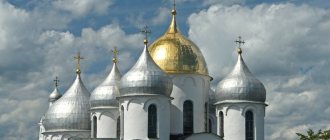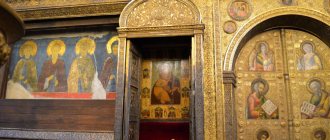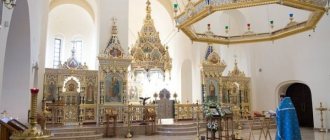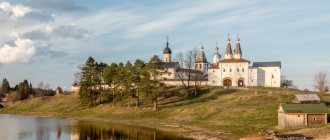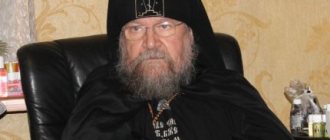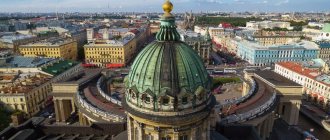Mir
Russia Moscow Epiphany Cathedral in Elokhov (Moscow) Map is loading...
{"format":"leaflet","minzoom":false,"maxzoom":false,"limit":50,"offset":0,"link":"all","sort":[""], "order":[],"headers":"show","mainlabel":"","intro":"","outro":"","searchlabel":"\u2026 \u0441\u043b\u0435\ u0434\u0443\u044e\u0449\u0438\u0435 \u0440\u0435\u0437\u0443\u043b\u044c\u0442\u0430\u0442\u044b","default":"","import-annotation":false,"width ":"auto","height":"350px","centre":{"text":"","title":"""link":"""lat":55.7727799999999973579178913496434688568115234375,"lon": 37.67472000000000065256244852207601070404052734375,"icon":""},"title":"","label":"","icon":"","lines":[],"polygons":[],"circles":[ ],"rectangles":[],"copycoords":false,"static":false,"zoom":8,"defzoom":14,"layers":["OpenStreetMap"],"image layers":[] ,"overlays":[],"resizable":false,"fullscreen":true,"scrollwheelzoom":true,"cluster":false,"clustermaxzoom":9,"clusterzoomonclick":true,"clustermaxradius":80, "clusterspiderfy":true,"geojson":"","clicktarget":"","showtitle":true,"hidenamespace":false,"template":"","userparam":"","activeicon": "","pagelabel":false,"ajaxcoordproperty":"","ajaxquery":"","locations":[{"text":"\u003Cb\u003E\u003Ca href=\"/palomnik/%D0% 91%D0%BE%D0%B3%D0%BE%D1%8F%D0%B2%D0%BB%D0%B5%D0%BD%D1%81%D0%BA%D0%B8%D0%B9_% D1%81%D0%BE%D0%B1%D0%BE%D1%80_%D0%B2_%D0%95%D0%BB%D0%BE%D1%85%D0%BE%D0%B2%D0% B5_(%D0%9C%D0%BE%D1%81%D0%BA%D0%B2%D0%B0)\» title=\»\u0411\u043e\u0433\u043e\u044f\u0432\u043b\u0435\ u043d\u0441\u043a\u0438\u0439 \u0441\u043e\u0431\u043e\u0440 \u0432 \u0415\u043b\u043e\u0445\u043e\u0432\u0435 (\u041c\u043e\ u0441\u043a\u0432\u0430)\ »\u003E\u0411\u043e\u0433\u043e\u044f\u0432\u043b\u0435\u043d\u0441\u043a\u0438\u0439 \u0441\u043e\u0431\u043e\u0440 \u0432 \u0415\u043b\u043e\u0445\ u043e\u0432\u0435 (\u041c\u043e\u0441\u043a\u0432\u0430)\u003C/a\u003E\u003C/b\u003E\u003Chr /\u003E\u003Ca href=\"/palomnik/%D0%A1% D0%B2%D0%BE%D0%B9%D1%81%D1%82%D0%B2%D0%BE:%D0%90%D0%BD%D0%BD%D0%BE%D1%82%D0 %B0%D1%86%D0%B8%D1%8F\" title=\"\u0421\u0432\u043e\u0439\u0441\u0442\u0432\u043e:\u0410\u043d\u043d\u043e\u0442\u0430\ u0446\u0438\u044f\»\u003E\u0410\u043d\u043d\u043e\u0442\u0430\u0446\u0438\u044f\u003C/a\u003E: »'\u0411\u043e\u0433\u043e\u0 44f\u0432\u043b \u0435\u0301\u043d\u0441\u043a\u0438\u0439 \u043a\u0430\u0444\u0435\u0434\u0440\u0430\u0301\u043b\u044c\u043d\u044b\u0439\ u0441\u043e\u0431\u043e\u0301 '' 432\u043d\u044b\u0439\u0445 \u0440\u0430\u043c \u0411\u043e\u0433\u043e\u044f\u0432\u043b\u0435\u043d\u0441\u043a\u043e\u0433\u043e \u0431\u043b\u0430\ u0433\u043e\u0447\u0438\u043d \u0438\u044f \u041c\u043e\u0441\u043a\u043e\u0432\u0441\u043a\u043e\u0439 \u0433\u043e\u0440\u043e\u0434\u0441\u043a\u043e\ u0439\u0435\u043f\u0430\u0440 \u0445\u0438\u0438. 1991 1991 u0431\u043e\u0440\u041c\u043e\ u0441\u043a\u043e\u0432\u0441\u043a\u043e\u0433\u043e \u041f\u0430\u0442\u0440\u0438\u0430\u0440\u0445\u0430\u0442\u0430; \u0432 1938\u20141991 \u0433\u043e\u0434\u0430\u0445 \u0431\u044b\u043b \u041f\u0430\u0442\u0440\u0438\u0430\u0440\u0448\u0 438\u043c\u043a\u0430\u0444\u0435\ u0434\u0440\u0430\u043b\u044c\u043d\u044b\u043c \u0441\u043e\u0431\u043e\u0440\u043e\u043c.","title":"\u0411\u043e\u0433\u043e\u0 44f\u0432\ ( u041c\u043e\u0441\u043a\u0432 \u0430)","link":"","lat":55.7727799999999973579178913496434688568115234375,"lon":37.67472000000000065256244852207601070404052734375, "icon":""}],"imageLayers":[]}
55.772613; 37.674759
Russia, Moscow, Spartakovskaya street, 15
Moscow
Russia
Telephone
: +7 (499) 261-69-13
Epiphany Cathedral in Yelokhov
- Orthodox Church of the Epiphany Deanery of the Moscow City Diocese. Since 1991, the Cathedral of the Moscow Patriarchate; in 1938-1991 it was the Patriarchal Cathedral.
History[edit]
In the XIV-XVII centuries the village of Eloh was located here. “Elokh”, “elokha”, according to Dahl’s dictionary, means alder, and probably once a dense alder forest grew here. In the old days, “alder” was also the name given to a wet, flooded place.
In the second half of the 15th century, Elokhovo was a suburban village near Moscow, where the Church of the Vladimir Icon of the Mother of God stood. In her parish in 1468 the famous Moscow holy fool Basil the Blessed was born.
Old Basmannaya, which led both to Elohovo and to the German settlement spread behind it, was the central street of the palace Basmannaya settlement, where the royal bakers settled (from the Tatar “basman” - palace or state bread), or according to the old, less probable version, silversmiths.
And the Epiphany Cathedral in ancient times may have been an ordinary rural church. It has been documented since 1687, and already in 1712-1731. was rebuilt in stone, at the expense of his parishioner, Colonel Voronetsky and Princess Praskovya Ivanovna. The bricks for it were donated personally by Peter I. Construction took a long time, and it was consecrated only in 1731.
At the end of the 18th century, the Pushkin family became parishioners of the old Peter the Great Epiphany Church. It is known that the great poet was born in the German settlement and was baptized in the old Epiphany Cathedral in 1799. The successors were the grandmother, Olga Sergeevna, nee Chicherina, and Count Vorontsov, the grandson of the minister Artemy Volynsky, who was martyred under Biron.
It was from the entry in the metric book of the Epiphany Cathedral, discovered in 1927, that it was established in which house the Russian poet was born. For a long time, his address was considered to be the house of the titular councilor Skvortsov at 40 Nemetskaya Street, where the Pushkins rented an apartment. It was not preserved; a school building was built in its place, on which a memorial plaque was installed in the same 1927. A modern researcher of the history of old Moscow, S. Romanyuk, has established that Pushkin was born in house No. 4 on Malaya Pochtovaya Street.
The old Peter's Cathedral stood until the middle of the 19th century. In the 1830s, the order for its reconstruction was received by the famous Moscow architect Evgraf Tyurin, who became famous for the construction of the house church of St. Tatiana Moscow University and its Auditorium building on Mokhovaya.
And in October 1853, the renewed, beautiful, majestic Epiphany Cathedral was consecrated.
After the revolution, this temple did not close. On the Feast of the Presentation in 1925, the solemn Liturgy was served there by His Holiness Patriarch Tikhon.
And in February 1935, the Baumansky district council, referring to the “instructions of voters,” decided to open one of the largest cinemas in the city in the Epiphany Cathedral. Fortunately, this decision was not destined to come true. Soon the department of the Patriarchal Locum Tenens, Metropolitan Sergius (Stragorodsky), who became Patriarch in September 1943, moved here from the destroyed Epiphany Church in Dorogomilov. After his death in 1944, he was buried in the northern Nikolsky chapel of the cathedral.
In the Epiphany Cathedral, on the choir to the south of the Royal Doors of the main altar, rest the relics of St. Alexis, Metropolitan of Moscow.
As is known, after his death the saint was buried in the Kremlin Chudov Monastery, which he founded, where his St. the relics rested until the revolution. And in 1928, during the destruction of the Miracle Monastery, they were first transferred to the closed Archangel Cathedral of the Kremlin, and in 1947, at the request of Patriarch Alexy I (Simansky) and with the personal permission of Stalin, they were given back to the Orthodox Church and transferred to the Epiphany Cathedral in Elokhov.
The Epiphany Cathedral was especially subjected to insults and attacks from “militant atheists” during the period of Khrushchev’s persecution of the Church. Once, during an all-night vigil on Palm Sunday, an unknown person burst into the church and hit Patriarch Alexy, who was performing the service. Another time, a religious procession, also led by the Patriarch, was met by a drunken crowd with guitars and obscene songs, with which they tried to drown out the church singing. Stones were thrown at the believers, and one of them seriously wounded a French embassy employee who was present at the religious procession in the head.
When at the beginning of 1992 the Assumption Cathedral of the Moscow Kremlin became Patriarchal, the Epiphany Cathedral became a cathedral.
Architecture of the Epiphany Cathedral
The Yelokhovsky Church managed to survive, and if the full religious life of the cathedral was in full view of the world, now the time has come to determine its significance as a national architectural monument.
The Church of the Epiphany of the Lord was founded in the 17th century. Initially it was wooden. In 1722 - 1731, a stone church with a chapel dedicated to the Annunciation of the Blessed Virgin Mary was built.
In 1790 - 1792, a chapel in the name of St. Nicholas the Wonderworker was added to the temple and the Annunciation chapel was rebuilt. This church is especially close to every Russian person because Alexander Sergeevich Pushkin was baptized there on his eighth day of birth.
In 1845, a stone church was built, which is characterized by the style of late classicism and empire style. Despite the fact that E.D. Tyurin created the Elokhovskaya Church within the framework of the European order culture; he did not deviate from the traditional cube in Orthodox architecture, completed with a canonical five-domed structure.
Epiphany Cathedral in 1882
In designing the external decoration of the cathedral, Tyurin continued to follow the requirements of the academic canon: it emphasized the proportional proportions of parts of architectural volumes, and found a successful relationship between the main building and the canonical five-domed structure.
At the same time, the architect remarkably transformed the drums of the domes, characteristic of temples of the medieval period, into representative rotunda pavilions with large window openings. Their small bindings create a feeling of lightness and airiness.
The pairs of columns separating them completely cover the walls between them, enhancing the effect of upward movement. The central dome seems to float among similar other four domes, defining the main vertical axis of the structure.
The northern and southern walls of the cathedral in the name of the Epiphany of the Lord are decorated with protruding portals-risalits with colonnades and paired pilasters, as if supporting an entablature. At the top between them is a wide semi-oval window supported by two round colonnades. This decoration gives the Church building lightness and elegance.
The bell tower of the cathedral is an amazingly beautiful vertical structure consisting of decreasing elongated quadrangles stacked on top of each other. Their walls are cut through with wide through arches.
The lower register of the bell tower is of a ceremonial character: each of the three sides is crowned with arches, above which there are triangular spread pediments supported by pairs of round columns.
On the second and third tiers, one round column is placed in the corners. They seem to be “pressed” at an angle by wide pilasters, which in turn flank the arches of the bells. The last register of the bell tower is freed from decorative elements. It is crowned with a light gilded dome with a cross.
Thanks to the through bell arches and subtle white architectural decor, this amazing structure acquires transparent lightness and weightlessness.
The main bells of the cathedral have been preserved, except for one – a large one. The crack that formed in the multi-ton mass of metal distorted the purity of its tone. The bell had to be replaced with another one, cast in 1900 and purchased from the Bolshoi Theater of Russia.
Adjacent to the western wall of the temple is a preserved refectory from the late 18th century. Its walls, stretched along the street, are cut through by rectangular windows with triangular pediments. They are separated by white pilasters. The corners of the end of the refectory, connected by the time of creation with the first tier of the bell tower, are softly beveled and decorated with horizontal cut lines.
The first additions were made in 1889 by architect P.P. Zykov. He decorated its restrained appearance with a number of details: a wide and squat figured dome resting on a solid iron drum, an extended attic along the facade with a three-arched portico highlighted in its center.
Entering the temple through the spacious vestibule of the bell tower, worshipers find themselves in a wide refectory with low arches resting on two quadrangular pillars. The refectory is connected to the main temple by a small passage, on the walls of which eight icons are placed.
Useful information for tourists
The Cathedral in Elokhov is a functioning Orthodox church that plays a huge role in the spiritual life of Russians. Many Muscovites, and even those who live far from the Basmanny district, treat the old temple with reverence. A Sunday school for children and adults is open at the cathedral.
Church services are held every day. Early liturgy begins at 6:30, late - at 8:00 or 9:30, vespers and all-night vigil - at 17:00. The full schedule of services can be found on the official website of the cathedral.
Interior decoration of Yelokhovsky Cathedral
On one of the walls there is a memorial plaque that reminds of the baptism of Alexander Sergeevich Pushkin under the arches of the cathedral.
Church interiors
A trembling feeling covers everyone who enters the space of the main part of the cathedral. The gazes of the parishioners are directed upward - towards the image of the New Testament Trinity. Her image is crowned with the mirror of the dome of the central rotunda of the temple.
The light pouring in a powerful stream from the windows seems to enlarge the space of the cathedral church in the name of the Holy Epiphany and illuminates the images of Russian saints depicted around the drum:
- Saints Equal to the Apostles Grand Duke Vladimir and Grand Duchess Olga,
- Holy Blessed Prince Alexander Nevsky,
- Holy Blessed Prince Daniel of Moscow,
- Venerable Sergius of Radonezh,
- Saint Tikhon of Zadonsk,
- Saints Michael, Peter, Alexy, Jonah, Wonderworkers of All Russia,
- Saint Demetrius of Rostov and Blessed Basil, Christ for the Fool's sake, Moscow wonderworker.
The majestic rotunda, resting on sails with images of the holy apostles and evangelists John the Theologian, Mark, Luke and Matthew, seems to cover the entire temple space.
The architectural role of the rotunda becomes dominant in the interior of the cathedral. This large-scale and amazingly beautiful structure is supported by giant supporting arches. They are supported by four powerful tetrahedral pillars with beveled corners, a pair of which are hidden from the eyes of worshipers by the iconostasis. The pillars bear the entire weight of the cathedral vaults.
The eastern wall of the temple is decorated with an eighteen-meter complex iconostasis. Its lush gilded floral ornament is made in the traditions of Russian carving. The elongated images of the iconostasis with semicircular ends were painted according to the academic canons of the Russian Orthodox Church of the 19th century (the so-called light-and-shadow style).
Over the past thirty years, some changes have occurred in the Epiphany Cathedral, caused by vital necessity. In the 1970s, the previously unfinished apse was reconstructed, in which the space of the main altar was significantly expanded.
Restoration work at the Epiphany Cathedral has been carried out almost constantly since the 1970s. During this time, it was possible to wash, strengthen and tint a huge area of wall paintings, and reconstruct its courtyards and adjacent buildings.
In 1987, labor-intensive work began on the restoration of the main iconostasis, and today, thanks to the efforts of skilled craftsmen, it surprises and delights parishioners with its grandeur.
Abbots, clerics
- Ioann Berezkin [1] (1884 - December 1, 1919)
- Nikolai Bogolyubsky (1920 - 1922)
- Nikolai Kolchitsky (December 27, 1924 - January 11, 1961)
- Donat (Shchegolev) (1951 - 1955 [2])
- Pimen (Izvekov) (March - November 1961) v/u
- Nikolay Stepanyuk (1983 - October 17, 2019)
Heirs of Byzantium
Time flew by. Moscow was burning in fires during the testing years of the war with Napoleon. But the church survived. However, it was decided to reconstruct it. This was entrusted to Evgraf Dmitrievich Tyurin. He began working on the project in 1837, and 26 years later the temple was consecrated by Metropolitan Philaret. In those days, the idea of an empire that united vast expanses was dominant. It's not that bad. Empire is an ancient concept that came to us from the East through Byzantium, or as they themselves called their state, the “Roman Empire,” which preserved the traditions of the Roman Empire, Roman law and Orthodoxy. So, the new church was conceived and built in the imperial Empire style. Its greatness was supposed to emphasize the defeat of Napoleon, the capture of Paris, and the dream of the high destinies of the country.
The bourgeois son, a talented architect, designed and built a grandiose cathedral with five domes. The central dome is as powerful as Michelangelo's architectural structures in Rome. The bell tower points like a needle into the sky and still rises above all the surrounding buildings. Almost all the bells that were installed during construction have been preserved in it. This is an old, often one-story, Basmanny district . Bauman Elokhovskaya Church is the central unifying core of this place. Shining with azure and golden domes, it stands out brightly from the discreet landscape and attracts the eye. It's impossible to pass by. Let's go into it.
The entrances are triumphal arches. The inside of the Yelokhovskaya Church on Baumanskaya is newly painted, and the iconostasis is gilded in five tiers. Radiance, Byzantine luxury, incense, prayer - an atmosphere that fascinates and immerses you in thoughts far from everyday life. The soul is strengthened and imbued with purity and poetry. She is filled with humility, patience and love. The fallen one rises by an unknown force. The seeker gradually begins to figure out what he should live for and what he should die for. It is not for nothing that the central rotunda is so large that it can accommodate thousands of people with various prayers and infirmities. Light enters it through high windows. Large side entrances are separated by columns. Each chapel has its own name. The church never closed, although it was threatened with such a sad fate - to become a cinema or even be destroyed.
External and internal decoration
The temple was built in the Empire style and looks elegant. It has light green walls on the outside and modest white decorations, as well as 5 golden domes. Near the cathedral there is a low bell tower with a clock at the top - it faces in all directions.
The inside of the temple has rich decoration with a predominance of gold. All walls and ceilings are covered with paintings . All of them were restored in the last century . You can view the interior on the website in a virtual tour.
